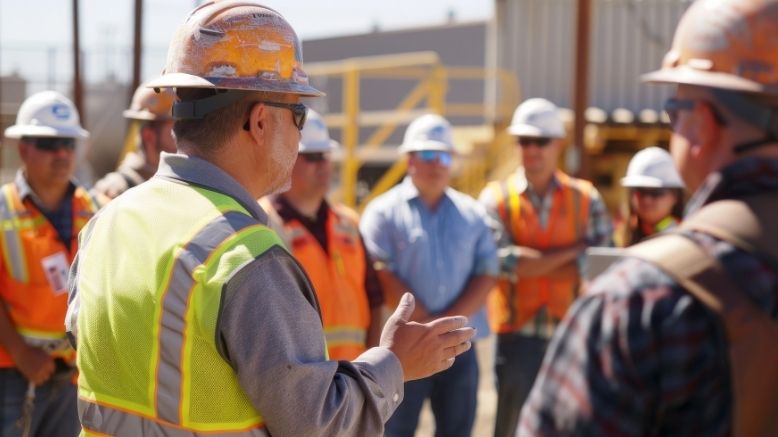— 5 min read
How to Win Acceptance of Safety Wearables in 3 Simple Steps


Last Updated Nov 5, 2025

Zachary Kiehl
Co-Founder and CEO
Zachary Kiehl is the co-founder and CEO of VigiLife, the company behind SafeGuard, a real-time safety platform that protects frontline workers using wearable tech and smart data. His work has supported everything from heat stress prevention to emergency response, with clients ranging from Fortune 500 companies to the Department of Defense. He earned biomedical engineering degrees from Wright State and an MBA from Indiana University. He’s a patented inventor, certified PMP, and a frequent speaker on topics like workplace safety, wearable tech, and building mission-driven companies.

Diane McCormick
Writer
49 articles
Diane McCormick is a freelance journalist covering construction, packaging, manufacturing, natural gas distribution, and waste oil recycling. A proud resident of Harrisburg, PA, Diane is well-versed in several types of digital and print media. Recognized as one of the premier voices in her region, she was recognized as the Keystone Media Freelance Journalist of the Year in 2022 and again in 2023.
Last Updated Nov 5, 2025

Wearable safety devices are revolutionizing construction — but before they can start delivering wellness and productivity benefits, they must win acceptance.
The new generation of digital tools proves that safety and privacy can coexist, as workers gain protection and insight without surrendering control of personal data. A layering approach eases wearables onto the jobsite, recognizing that people are being asked to don devices that track everything from their core temperature to their heart rate.
Acceptance emerges from logical sequencing. Long before the devices are delivered and unboxed, all stakeholders — especially the people being asked to wear them — must understand their purpose and functions.
This article explores a three-step approach to winning buy-in of safety wearables. Put the steps together, and wearables deliver on the promise of safer, healthier jobsites — and as a result, higher productivity.
Step 1. Crawl-Walk-Run Implementation
Methodical change management that eases wearables into use can overcome wariness by preparing workers to adopt the technology.
It begins with thorough understanding of the devices. Research their capabilities, impact on the full range of operations, upfront and hidden costs, and ROI.
As system selection and implementation is underway, develop relationships with every stakeholder who must and should have a say. For instance, engaging unions as early as possible can prevent them from stalling momentum. Even if they aren’t opposed to wearables, they want the opportunity to have a say in the plan and protect the interests of their members.
The IT team also requires attention. Work to align their capabilities and schedules to the new task on their worklists. Have conversations about their comfort levels with installing apps on company or personal cell phones. Help them learn the sophisticated technology behind wearables and how they differ from personal smartwatches.
Choice of format can make a difference when it’s time for rollout. People are more open to try the things they already enjoy wearing, such as smartwatches popular for their wear-it-and-forget-it usefulness.
On sites where watches create snare and entrapment hazards, chest straps, armbands, and shirts can provide the same protection, tucked discreetly under clothing and PPE.
If folks like wearing what they're asked to wear, it often is not a problem.

Zachary Kiehl
Co-Founder and CEO
VigiLife
When users get the apps for their wearables, they consent to the terms, but creating procedures for starting and stopping daily monitoring sessions adds another layer of consent. The additional step reinforces acceptance every time users make the conscious choice to opt in.
When company officials and workers have questions, device vendors have answers. They know all the objections and concerns. They should be experts in the human side of wearables as well as the technical side. To maximize the investment, look for suppliers with proven value-adds in deployment, training, and data analysis.
There's really a lot of organizational psychology into this, as well. The tech could be perfect, and we often ask ourselves, ‘Why did that pilot go well, and that one maybe not as well?’ . . . We often are asking ourselves those types of questions as far as how we can enact change management (and) innovation within some of these organizations that are naturally a little resistant.”
Zachary Kiehl
Co-Founder and CEO
VigiLife
Step 2. Make room for champions — and naysayers.
Every company has early adopters of technologies that enhance health and safety. They buy devices for themselves or experiment with the latest apps. These early adopters can be cultivated as champions for wearables.
The champions can be the first to try the device. If management did its due diligence in finding the best fit, a pilot test should go well. The bugs are worked out, and the champion becomes a trusted voice telling colleagues how the device makes the day better.
The champion can name the sites and teams open to trying the new devices, for a head start on success. Champions can also take the lead in train-the-trainer models, streamlining adoption throughout the company and from site to site.
Chances are, skeptics also abound. Early conversations with them reaps feedback on the obstacles and roadblocks to address.
In fact, some of the most powerful champions are former skeptics, transformed by a lifesaving experience and living to tell their tales. Even the doubters who never become converts may be less likely to actively subvert the effort because someone heard them out.
Free AI in Construction Course with Hugh Seaton
Start learning today with industry expert Hugh Seaton and discover how AI can boost efficiency, reduce risk, and transform your projects.

Step 3: Tailor learning and education.
Preparation pays off in a smooth rollout, but the job of winning acceptance continues. The best programs are built collaboratively — with workers, and not just for them. Meeting the educational, training, and distinct needs of individuals and groups paves the way for enterprise-wide adoption and ROI.
Often, the hardest-to-reach crews are those who could benefit the most from technology tailored to their health and safety. But often, language barriers, distrust, and inaccessibility stand in the way. The technology itself offers solutions, such as wearables capable of launching monitoring sessions through a QR code scan — no translation or basic literacy required.
The individuals that need the technology the most are often the most difficult to reach.
Zachary Kiehl
Co-Founder and CEO
VigiLife
In training, never assume that everyone is familiar with the technology. Start with the basics, making sure that every worker knows how to download an app and use a smartwatch.
Lean into the willingness of 21st-century people to relinquish some privacy in exchange for value: For example, social media profiles that share personal information but offer social connections and one-click shopping in return. In that context, wearables can be presented as a partner for the core values of going home safely at the end of the day and staying well in mind and body.
Deliver additional value through incentives and recognition. A free smartwatch or rewards for being “caught” practicing a safe act can flip negative mindsets to positive.
Sharing the company wins, as seen in higher productivity and improved aggregate health data, adds the motivators of higher pay and steady work that come with business growth.
Employ customizable privacy controls, empowering users to maintain control over data sharing, deletion, and anonymization settings. Adoption rises when transparency becomes tangible and workers understand what is being collected and why.
The day that safety wearables arrive on the jobsite is a milestone, but it’s only the middle of the story. Preparing for that day demands due diligence and extensive communications and collaboration.
From there, ongoing dialog and training feed into strategic goals, when use of wearables becomes second nature and the investment yields returns of higher productivity and safer workers. The future of worksite safety is about empowering them. With the right approach, wearables can build trust as well as resilience.
Was this article helpful?
Thank you for your submission.
0%
0%
You voted that this article was . Was this a mistake? If so, change your vote
Scroll less, learn more about construction.
Subscribe to The Blueprint, Procore’s construction newsletter, to get content from industry experts delivered straight to your inbox.
By clicking this button, you agree to our Privacy Notice and Terms of Service.
Thank you!
You’re signed up to receive The Blueprint newsletter from Procore. You can unsubscribe at any time.
Categories:
Written by

Zachary Kiehl
Co-Founder and CEO | VigiLife
Zachary Kiehl is the co-founder and CEO of VigiLife, the company behind SafeGuard, a real-time safety platform that protects frontline workers using wearable tech and smart data. His work has supported everything from heat stress prevention to emergency response, with clients ranging from Fortune 500 companies to the Department of Defense. He earned biomedical engineering degrees from Wright State and an MBA from Indiana University. He’s a patented inventor, certified PMP, and a frequent speaker on topics like workplace safety, wearable tech, and building mission-driven companies.
View profile
Diane McCormick
Writer | Procore Technologies
49 articles
Diane McCormick is a freelance journalist covering construction, packaging, manufacturing, natural gas distribution, and waste oil recycling. A proud resident of Harrisburg, PA, Diane is well-versed in several types of digital and print media. Recognized as one of the premier voices in her region, she was recognized as the Keystone Media Freelance Journalist of the Year in 2022 and again in 2023.
View profileExplore more helpful resources

Defending Against Financial & Legal Risks on Megaprojects
The construction industry has seen marked growth in megaprojects. Some experts classify any project over $500 million as a megaproject, while others argue that the build needs to be $1...

Unlocking Project Intelligence: Moving from Raw Data to Actionable Insights
The construction industry faces a wide range of challenges, from ongoing labor shortages to frequent cost overruns. But some the biggest hurdles all stem from unpredictability. The general contractors (GCs)...

Who is accountable for innovation in construction?
Everyone says construction needs to innovate—but no one agrees on who’s actually responsible for making it happen. Is it the owner? The builders? The tech vendor? Or is innovation everyone’s...

Integrated Project Delivery in Practice: A Framework for Collaboration
On construction projects, traditional delivery methods put different stakeholders in their own silos. While the design team feeds drawings and specifications to the general contractor (GC), the GC’s expertise in...
Free Tools
Calculators
Use our calculators to estimate the cost of construction materials for your next project.
Templates
Find a template to help you with your construction project tasks.
Material Price Tracker
Get the latest U.S. retail prices and view historical trends for common building materials.
Glossary
Explore key terms and phrases used in the industry.
